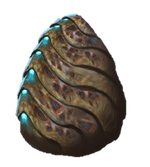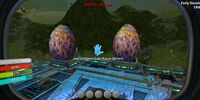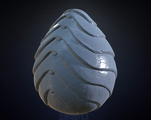Sea Emperor Leviathan Eggs
In the near future, five Sea Emperor Eggs will be located in the Primary Containment Facility along with the last adult Sea Emperor.
These eggs cannot hatch due to the Primary Containment Facility being built to match the ideal conditions for an adult Sea Emperor, which seem to be significantly different than the ideal conditions for a juvenile, as a result, these eggs have been in this state for many years. The eggs are attached to a piece of Precursor equipment that supplies them with what is necessary to keep them alive.
The player must hatch these eggs to cure himself of Carar in order for him to be able to leave the planet. To do so many plants must be gathered to create Hatching Enzymes. The eggs will be hatched in a similar way to how crafting works, giving the player a list of "actions" when accessing the egg incubator. The hatching enzymes will be removed from the players inventory and used to hatch the eggs.
Appearance
The Sea Emperor Eggs are very large, brown in colour, very similar to the skin of a Sea Emperor, they have many ridged layers, rows of bioluminescent cyan spots run vertically down opposite sides of the eggs.
Story
After being laid by the Sea Emperor, the Sea Emperor Eggs were taken away from their mother by the Precursors and placed on the Precursor Egg Incubator. This is because of the unnatural hatching conditions of the aquarium, and the Precursors wanting to study the eggs, as their mother was incapable of producing enough Enzyme 42 due to her age, and their deduction that the unborn Sea Emperors would be a much more viable source.
Future Plans
- The quantity of Sea Emperor Eggs laid by the captive Emperor may be changed in the future, though the number found in the Aquarium will still be five.[1]
Data Bank Entry
| 1. (Shell)
Uncommonly strong shell lining. Organic growth on the exteriors suggest these eggs may be hundreds of years old.
|
Gallery
<tabber> Images=
An early model of the Sea Emperor egg seen on Sketchfab
|-| Videos=
- Egg rig (WIP)
Animation rig
</tabber>
References
- ↑ http://imgur.com/xHGdrqz Dated March 20, 2017



